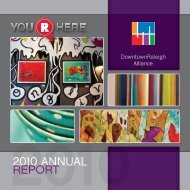Pedestrian Count Study - Downtown Raleigh Alliance
Pedestrian Count Study - Downtown Raleigh Alliance
Pedestrian Count Study - Downtown Raleigh Alliance
You also want an ePaper? Increase the reach of your titles
YUMPU automatically turns print PDFs into web optimized ePapers that Google loves.
5.5 Conclusion<br />
<strong>Downtown</strong> <strong>Raleigh</strong> is certainly an up and coming gem in the southeast.<br />
Already, the city has been awarded national accolades presenting<br />
<strong>Raleigh</strong> as one of the top places to live and raise families. With the<br />
revitalization of Fayetteville Street from pedestrian mall to vehicular path<br />
with a myriad of pedestrian amenities, businesses including restaurants<br />
and retail establishments experience an increase in exposure. Events and<br />
programming in the downtown area also encourage use, as can be seen<br />
during festivals such as <strong>Raleigh</strong> Wide Open. Although <strong>Raleigh</strong> contains<br />
an extensive suburban area, this study shows a large population using<br />
and navigating the downtown area. Particularly during the lunch period,<br />
pedestrians proliferate the downtown area, presumably as they dine<br />
out, which contributes to the overall economy of the city. Increasingly<br />
restaurants are adding sidewalk seating to their dining capacity, even<br />
in tight spaces such as Remedy Diner’s storefront. Coupled with further<br />
studies vetting pedestrian preference, each location’s trends, total<br />
counts, and pedestrian per hour statistics can lead to an understanding<br />
of programmatic and land use recommendations for underperforming<br />
blocks. Sidewalk characteristics including width, furnishings, trees, and<br />
lighting can also affect use and could be explored further with surveys<br />
and interviews.<br />
As seen in the comparative city studies, the volume of traffi c in the <strong>Raleigh</strong><br />
study area tends to exceed the volume of small and even larger cities. A<br />
further in-depth study of land use could compare Knoxville, Greensboro,<br />
and San Diego’s retail, offi ce and restaurant ratios to pedestrian volume.<br />
This study would provide a foundation to illustrate to potential occupants<br />
that <strong>Raleigh</strong> possesses suffi cient pedestrian volume to support new<br />
businesses.<br />
While scientifi c methods can assist in decision making for design<br />
and amenities for sidewalks, empirical evidence and the element of<br />
experience must not be overlooked. Great streets have been explored<br />
in literature by Jane Jacobs, William Whyte, Jan Gehl, and Allen Jacobs<br />
as well as across many disciplines including planning, design, sociology,<br />
psychology and other fi elds related to human behavior. Context plays<br />
a key role in pedestrian use, as seen in the Warehouse District and<br />
Glenwood South, where foot traffi c does not stop due to lack of sidewalk<br />
width or the intimidation of crossing rail lines.<br />
Overall, this study provides a snapshot of pedestrian activity in three of<br />
<strong>Raleigh</strong>’s districts. Total volumes and pedestrian per hour statistics can<br />
immediately enable the DRA to present evidence to potential occupants<br />
that <strong>Raleigh</strong> has suffi cient pedestrian activity to support consumer<br />
activities. Over time, it is recommended this study be repeated to identify<br />
trends; supplemented to explore pedestrian preferences; and expanded<br />
to analyze land use.<br />
5.14-City Comparisons | <strong>Downtown</strong> <strong>Raleigh</strong> <strong>Alliance</strong>







